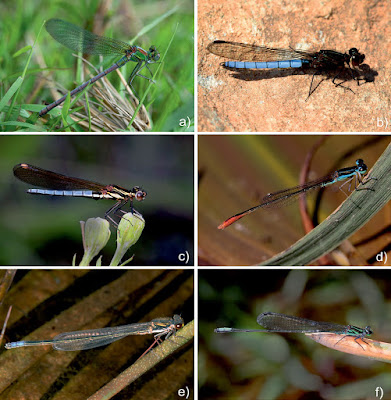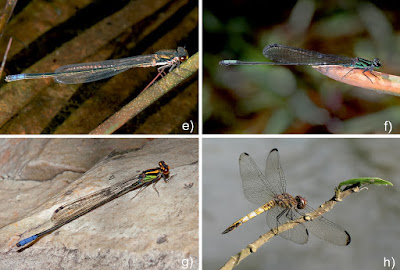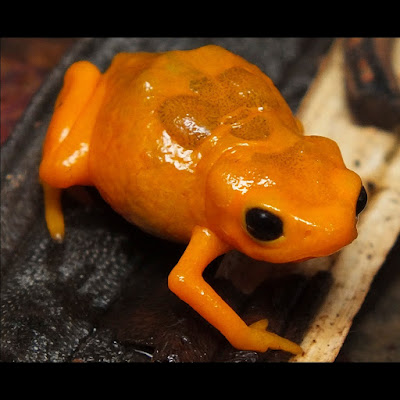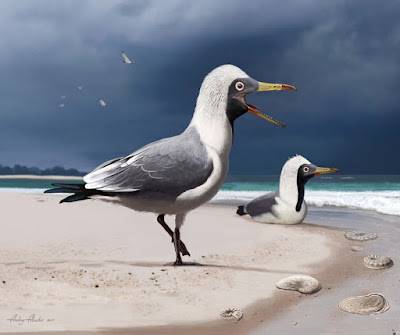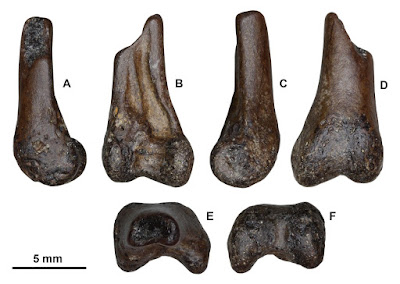![]() |
Ophryophryne elfina
Poyarkov, Duong, Orlov, Gogoleva, Vassilieva, Nguyen, Nguyen, Nguyen, Che & Mahony, 2017
adult male of Ophryophryne elfina sp. n. in calling position in Hon Ba N.R., Khanh Hoa Prov., Vietnam, 1510 m a.s.l.,
|
Abstract
Asian Mountain Toads (Ophryophryne) are a poorly known genus of mostly small-sized anurans from southeastern China and Indochina. To shed light on the systematics within this group, the most comprehensive mitochondrial DNA phylogeny for the genus to date is presented, and the taxonomy and biogeography of this group is discussed. Complimented with extensive morphological data (including associated statistical analyses), molecular data indicates that the Langbian Plateau, in the southern Annamite Mountains, Vietnam, is one of the diversity centres of this genus where three often sympatric species of Ophryophryne are found, O. gerti, O. synoria and an undescribed species. To help resolve outstanding taxonomic confusion evident in literature (reviewed herein), an expanded redescription of O. gerti is provided based on the examination of type material, and the distributions of both O. gerti and O. synoria are considerably revised based on new locality records. We provide the first descriptions of male mating calls for all three species, permitting a detailed bioacoustics comparison of the species. We describe the new species from highlands of the northern and eastern Langbian Plateau, and distinguish it from its congeners by a combination of morphological, molecular and acoustic characters. The new species represents one of the smallest known members of the genus Ophryophryne. At present, the new species is known from montane evergreen forest between 700–2200 m a.s.l. We suggest the species should be considered Data Deficient following IUCN’s Red List categories.
Keywords: 12S rRNA, 16S rRNA, advertisement call, amphibian, biodiversity, Da Lat Plateau, frog, Indochina, southeast Asia, taxonomy, Truong Son
Figure 13. Comparison of the head coloration in life of three Ophryophryne species from the Langbian Plateau: A Ophryophryne synoria, Bu Gia Map N.P., Binh Phuoc Prov., Vietnam B Ophryophryne gerti, Chu Yang Sin N.P., Dak Lak Prov., Vietnam C Ophryophryne elfina sp. n., Hon Giao Mt., Bidoup–Nui Ba N.P., Lam Dong Prov.
Photos by N.A. Poyarkov and N.L. Orlov.
![]()
![]() |
Figure 6. Ophryophryne species of the Langbian Plateau (Vietnam):
A Ophryophryne gerti, female, Chu Yang Sin N.P., Dak Lak Prov., 1000 m a.s.l. B O. gerti, male, Chu Yang Sin N.P., Dak Lak Prov., 1000 m a.s.l. C O. gerti, male, Bidoup–Nui Ba N.P., Lam Dong Prov., 1550 m a.s.l. D O. synoria, female, Bu Gia Map N.P., Binh Phuoc Prov., 400 m a.s.l. E O. synoria, male, Chu Yang Sin Mt., Chu Yang Sin N.P., Dak Lak Prov., 1000 m a.s.l. F O. synoria, male, Bidoup–Nui Ba N.P., Lam Dong Prov., 1550 m a.s.l. G Ophryophryne elfina sp. n., male, Chu Yang Sin Mt., Chu Yang Sin N.P., Dak Lak Prov., 2000 m a.s.l. H Ophryophryne elfina sp. n., male, Hon Giao Mt., Bidoup–Nui Ba N.P., Lam Dong and Khanh Hoa provincial border, 2000 m a.s.l.
Photos by N.A. Poyarkov and N.L. Orlov. |
• Taxonomic remarks on Ophryophryne gerti Ohler, 2003
Redescription of the holotype: Mature male (SVL 35.7 mm), habitus slender (Fig. 7A, B). Specimen in good state of preservation; two incisions are present on trunk, one longitudinally orientated on mid-abdomen, another longitudinally oriented on upper flank on right side; liver and testes observable through incisions, testes enlarged; jaw is dislocated on right allowing visual access to buccal cavity. .....
Vernacular name: English: “Gerti’s Mountain Toad”; Vietnamese: “Cóc Núi Got” (Nguyen et al. 2009), “Cóc Núi Goti” (Nguyen et al. 2014).
• New records and range extension for Ophryophryne synoria Stuart, Sok & Neang, 2006
Distribution and remarks: Stuart et al. (2006) described a large-sized Ophryophryne from O’Rang (also spelled as “O’Reang”) District in eastern Cambodia, close to the Vietnamese border, as O. synoria (Loc. 1, Fig. 1). Subsequently, during field surveys in 2009–2011, the species was reported in southern Vietnam from Bu Gia Map N.P., Binh Phuoc Prov. (Loc. 2, Fig. 1) and Cat Tien N.P. in Dong Nai Prov. (Loc. 3, Fig. 1) based on morphological evidence (Vassilieva et al. 2016). Herein, we confirm the identity of these specimens based on morphological and molecular genetic evidence, and further expand its distribution in southern Vietnam to include medium and low elevation localities in the central and western parts of the Langbian Plateau (Dak Lak, Lam Dong, Dong Nai and Binh Phuoc provinces between 200 and 1500 m a.s.l.; its presence in Dak Nong Prov. is anticipated). We also identify two mtDNA lineages within O. synoria with a moderate level of sequence divergence (p = 2.6%: Table 2, Fig. 2): Subclade B inhabits mountain areas in Lam Dong and Dak Lak provinces and was also recorded for the lowland habitat in Dong Nai Prov. (Locs. 3–4, 6 and 11, Fig. 1) whereas Subclade C is only found in Mondolkiri Prov. of Cambodia and adjacent Binh Phuoc Prov. of Vietnam (Fig. 1, Locs 1–2) and corresponds to O. synoria s. stricto.
Vernacular name: English: “O’Reang Mountain Toad” (this paper); “O’Reang horned frog” (Vassilieva et al. 2016); Vietnamese: “Cóc Núi O-Reng” (Vassilieva et al. 2016).
.....
![]() |
Figure 14. Ophryophryne elfina sp. n. in situ:
A Two syntopically collected males of Ophryophryne gerti (left) and Ophryophryne elfina sp. n. (right) in Chu Yang Sin N.P., Dak Lak Prov., Vietnam, 1750 m a.s.l., photo by N.L. Orlov B calling adult male of Ophryophryne elfina sp. n. in Nui Chua Mt., Nui Chua N.P., Ninh Thuan Prov., Vietnam, 780 m a.s.l., photo by S.N. Nguyen C adult male of Ophryophryne elfina sp. n. in calling position in Hon Ba N.R., Khanh Hoa Prov., Vietnam, 1510 m a.s.l., photo by L.T. Nguyen. |
• Description of a new species of Ophryophryne
Based upon several lines of evidence, including the analyses of diagnostic morphological characters, acoustic analyses of advertisement calls and phylogenetic analyses of mtDNA sequences for the 12S rRNA–16S rRNA genes, the new species of Ophryophryne from mid to high elevations of the western Langbian Plateau represents a highly divergent mtDNA lineage, clearly distinct from all other Ophryophryne species. These results support our hypothesis that this recently discovered lineage of Ophryophryne represents an undescribed species, described below:
Ophryophryne elfina sp. n.
Etymology: The specific epithet is an adjective (in agreement with the genus name in feminine gender), derived from “elf”, the English spelling of “alfus” in Latin, referring to usually forest-dwelling supernatural mythological creatures in Germanic mythology and folklore; the name is given in reference both to the funny appearance and small size of the new species, as well as to the their endangered habitat, restricted to wet evergreen montane forests at high elevations of the Langbian Plateau; such forests are often called “elfin forests”.
Recommended vernacular name: The recommended common name in English is “Elfin Mountain Toad”. The recommended common name in Vietnamese is “Cóc Núi Tiểu Yêu Tinh”.
![]() |
| Figure 9. Holotype of Ophryophryne elfina sp. n. in life (ZMMU A-5669, male, field number NAP-02658), dorsolateral view. Photos by N.A. Poyarkov. |
![]() |
Figure 10. Paratypes of Ophryophryne elfina sp. n. in life.
A–D Bidoup Mt., Bidoup–Nui Ba N.P., Lam Dong Prov., 2000 m a.s.l.: A ZMMU A-4788 (field number NAP-01449), male, dorsolateral view B ZMMU A-4788 (field number NAP-01455), female, dorsolateral view C ZMMU A-4788 (field number NAP-01449), male, ventral view D ZMMU A-4788 (field number NAP-01455), female, ventral view
E–F Chu Yang Sin Mt., Chu Yang Sin N.P., Dak Lak Prov., 1800 m a.s.l.: E ZMMU A-5691 (field number ABV-00580), metamorph, dorsolateral view F ZMMU A-5691 (field number ABV-00581), metamorph, dorsolateral view. Photos by N.A. Poyarkov. |
Distribution: Ophryophryne elfina sp. n. is found to be endemic to five provinces in (Lam Dong, Dak Lak, Khanh Hoa, Ninh Thuan and Phu Yen) in the northern and eastern part of the Langbian Plateau and its foothills in southern Vietnam (localities 6–12, Fig. 1). The new species is restricted to wet evergreen montane tropical and elfin forests, receiving high precipitation from the sea. Such wet forests are found only on high elevations in the central parts of the Langbian Plateau (e.g. 1900–2100 m a.s.l. on Bidoup Mt., Lam Dong Prov., Fig. 1, Loc. 6) or peripheral mountains remote from the sea (e.g. 1900–2300 m a.s.l. on Chu Pan Fan and Chu Yang Sin Mts., Dak Lak Prov., Fig. 1, Locs 10 and 11), but on the eastern foothills of the plateau which receive more precipitation, the new species is found at lower elevation (from 950 to 1510 m a.s.l. on Hon Ba Mt., Khanh Hoa Prov., Fig. 1, Loc. 8; 780 m a.s.l. on Nui Chua Mt., Ninh Thuan Prov., Fig. 1, Loc. 9; and 700 m in Phu Yen Prov., Fig. 1, Loc. 12).
.....
Nikolay A. Poyarkov Jr., Tang Van Duong, Nikolai L. Orlov, Svetlana S. Gogoleva, Anna B. Vassilieva, Luan Thanh Nguyen, Vu Dang Hoang Nguyen, Sang Ngoc Nguyen, Jing Che and Stephen Mahony. 2017. Molecular, Morphological and Acoustic Assessment of the Genus
Ophryophryne (Anura, Megophryidae) from Langbian Plateau, southern Vietnam, with Description of A New Species.
ZooKeys. 672: 49-120. DOI:
10.3897/zookeys.672.10624














